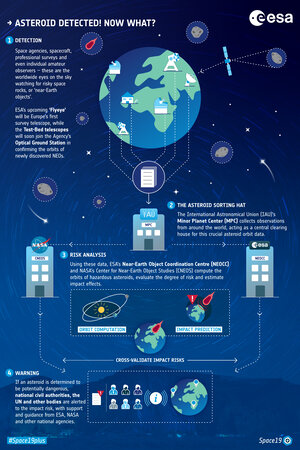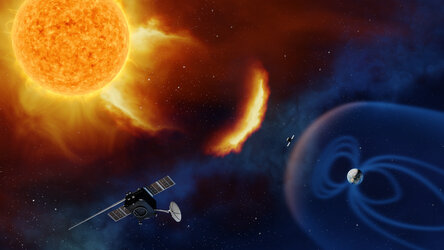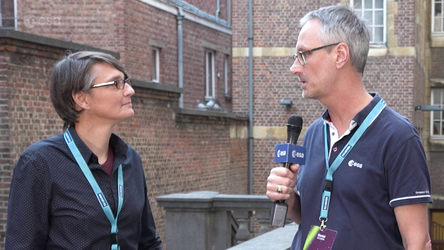Accept all cookies Accept only essential cookies See our Cookie Notice

About ESA
The European Space Agency (ESA) is Europe’s gateway to space. Its mission is to shape the development of Europe’s space capability and ensure that investment in space continues to deliver benefits to the citizens of Europe and the world.
Highlights
ESA - United space in Europe
This is ESA ESA facts Member States & Cooperating States Funding Director General Top management For Member State Delegations European vision European Space Policy ESA & EU Space Councils Responsibility & Sustainability Annual Report Calendar of meetings Corporate newsEstablishments & sites
ESA Headquarters ESA ESTEC ESA ESOC ESA ESRIN ESA EAC ESA ESAC Europe's Spaceport ESA ESEC ESA ECSAT Brussels Office Washington OfficeWorking with ESA
Business with ESA ESA Commercialisation Gateway Law at ESA Careers Cyber resilience at ESA IT at ESA Newsroom Partnerships Merchandising Licence Education Open Space Innovation Platform Integrity and Reporting Administrative Tribunal Health and SafetyMore about ESA
History ESA Historical Archives Exhibitions Publications Art & Culture ESA Merchandise Kids Diversity ESA Brand Centre ESA ChampionsLatest
Space in Member States
Find out more about space activities in our 23 Member States, and understand how ESA works together with their national agencies, institutions and organisations.
Science & Exploration
Exploring our Solar System and unlocking the secrets of the Universe
Go to topicAstronauts
Missions
Juice Euclid Webb Solar Orbiter BepiColombo Gaia ExoMars Cheops Exoplanet missions More missionsActivities
International Space Station Orion service module Gateway Concordia Caves & Pangaea BenefitsLatest
Space Safety
Protecting life and infrastructure on Earth and in orbit
Go to topicAsteroids
Asteroids and Planetary Defence Asteroid danger explained Flyeye telescope: asteroid detection Hera mission: asteroid deflection Near-Earth Object Coordination CentreSpace junk
About space debris Space debris by the numbers Space Environment Report In space refuelling, refurbishing and removingSafety from space
Clean Space ecodesign Zero Debris Technologies Space for Earth Supporting Sustainable DevelopmentLatest
Applications
Using space to benefit citizens and meet future challenges on Earth
Go to topicObserving the Earth
Observing the Earth Future EO Copernicus Meteorology Space for our climate Satellite missionsCommercialisation
ESA Commercialisation Gateway Open Space Innovation Platform Business Incubation ESA Space SolutionsLatest
Enabling & Support
Making space accessible and developing the technologies for the future
Go to topicBuilding missions
Space Engineering and Technology Test centre Laboratories Concurrent Design Facility Preparing for the future Shaping the Future Discovery and Preparation Advanced Concepts TeamSpace transportation
Space Transportation Ariane Vega Space Rider Future space transportation Boost! Europe's Spaceport Launches from Europe's Spaceport from 2012Latest

Inside ESA's new Space Safety Centre
Thank you for liking
You have already liked this page, you can only like it once!
ESA Director General Josef Aschbacher inside ESA's new Space Safety Centre
Living close to an active star, in a Solar System filled with ancient and fast-moving asteroids, on a planet that is becoming increasingly surrounded by discarded satellites and their debris, comes with a plethora of challenges. ESA’s Space Safety programme carries out the activities necessary to mitigate and prevent the effects of these hazards.
Inaugurated on 12 April, the new Space Safety Centre is a dedicated facility for the teams monitoring and responding to space weather. Electromagnetic radiation and charged particles hurled into space by the Sun can disrupt or damage active satellites, human space explorers and infrastructure on Earth such as power grids.
By monitoring the health of data arriving on Earth from our satellite instruments and from other space weather services, teams at ESA help keep spacecraft and astronauts safe from our star’s unpredictable outbursts, while contributing to the protection of civil infrastructure, like power grids, on ground.
The Space Safety Centre is a first for ESA and provides a dynamic environment where next-generation space-weather capabilities, tools and models will be developed, tested and evaluated in close cooperation with European institutes and industry.
The Centre also supports the provision of space weather information and warnings to ESA-operated space missions. It will work in close coordination with the Agency’s Space Weather Services Network, providing timely and reliable space weather information to European spacecraft operators, agencies, institutions, researchers and commercial sectors affected by solar activity including transportation, navigation and power grid operators.
Teams at the Centre will monitor data received from ESA’s space weather sensors, comprising, today, payloads onboard Proba-2 and hosted on missions flown by other agencies and, in future, additionally from the Vigil and Aurora missions and from new nanosatellite missions.
-
CREDIT
ESA / J. Mai -
LICENCE
ESA Standard Licence

ESA Director General Josef Aschbacher and Director R…

ESA Director General Josef Aschbacher inaugurates Sp…

Detection: What's the risk?

ESA's mission to monitor the Sun















 Germany
Germany
 Austria
Austria
 Belgium
Belgium
 Denmark
Denmark
 Spain
Spain
 Estonia
Estonia
 Finland
Finland
 France
France
 Greece
Greece
 Hungary
Hungary
 Ireland
Ireland
 Italy
Italy
 Luxembourg
Luxembourg
 Norway
Norway
 The Netherlands
The Netherlands
 Poland
Poland
 Portugal
Portugal
 Czechia
Czechia
 Romania
Romania
 United Kingdom
United Kingdom
 Slovenia
Slovenia
 Sweden
Sweden
 Switzerland
Switzerland
























